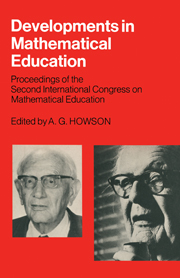 Developments in Mathematical Education
Developments in Mathematical Education Book contents
- Frontmatter
- Contents
- Editor's Acknowledgements
- PART I A CONGRESS SURVEY
- PART II THE INVITED PAPERS
- As I read them
- Comments on mathematical education
- The Presidential Address
- What groups mean in mathematics and what they should mean in mathematical education
- Nature, man and mathematics
- Some anthropological observations on number, time and common-sense
- Mathematical education in developing countries – some problems of teaching and learning
- Some questions of mathematical education in the USSR
- Modern mathematics: does it exist?
- PART III A SELECTION OF CONGRESS PAPERS
- Appendices
- Index
Nature, man and mathematics
from PART II - THE INVITED PAPERS
- Frontmatter
- Contents
- Editor's Acknowledgements
- PART I A CONGRESS SURVEY
- PART II THE INVITED PAPERS
- As I read them
- Comments on mathematical education
- The Presidential Address
- What groups mean in mathematics and what they should mean in mathematical education
- Nature, man and mathematics
- Some anthropological observations on number, time and common-sense
- Mathematical education in developing countries – some problems of teaching and learning
- Some questions of mathematical education in the USSR
- Modern mathematics: does it exist?
- PART III A SELECTION OF CONGRESS PAPERS
- Appendices
- Index
Summary
Several years ago, when I had brought home a new microscope designed for children's use, we had opportunity to observe the first recognition, by a five-year-old, of the world of size and scale. Or perhaps it was not the first, beginnings are hard to catch; and this fortunate young girl was already deeply involved with fragments of that world, at least – with dolls and furniture to scale, with pictures and maps of her own and others' drafting, and much else besides. But the world of size and scale is something else again, it is a recapitulation and a surmise; a glimpse of generality and of closure. At that young age the eyepiece of a microscope is first a shiny object and then, with luck, a sort of peep-show or television screen in miniature. At any rate we did what we all three, Christa, my wife, and I, called ‘looking at’ various objects. Some, which Christa brought for this new occupation, were ten or fifty times too big to fit between object and stage, and one saw a young child's perceptual unreadiness to make use of what might be called the transitivity of congruences.
But one evening Christa brought to the microscope a tiny bit of lint from the floor. Here for the first time there seemed to be recognition, the lint was seen as lint though transformed a hundred-fold in scale.
- Type
- Chapter
- Information
- Developments in Mathematical EducationProceedings of the Second International Congress on Mathematical Education, pp. 115 - 135Publisher: Cambridge University PressPrint publication year: 1973
- 5
- Cited by


